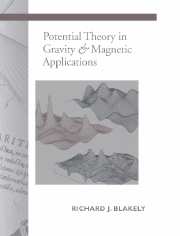Book contents
- Frontmatter
- Contents
- Introduction
- 1 The Potential
- 2 Consequences of the Potential
- 3 Newtonian Potential
- 4 Magnetic Potential
- 5 Magnetization
- 6 Spherical Harmonic Analysis
- 7 Regional Gravity Fields
- 8 The Geomagnetic Field
- 9 Forward Method
- 10 Inverse Method
- 11 Fourier-Domain Modeling
- 12 Transformations
- Appendix A Review of Vector Calculus
- Appendix B Subroutines
- Appendix C Review of Sampling Theory
- Appendix D Conversion of Units
- Bibliography
- Index
1 - The Potential
Published online by Cambridge University Press: 10 October 2009
- Frontmatter
- Contents
- Introduction
- 1 The Potential
- 2 Consequences of the Potential
- 3 Newtonian Potential
- 4 Magnetic Potential
- 5 Magnetization
- 6 Spherical Harmonic Analysis
- 7 Regional Gravity Fields
- 8 The Geomagnetic Field
- 9 Forward Method
- 10 Inverse Method
- 11 Fourier-Domain Modeling
- 12 Transformations
- Appendix A Review of Vector Calculus
- Appendix B Subroutines
- Appendix C Review of Sampling Theory
- Appendix D Conversion of Units
- Bibliography
- Index
Summary
Laplace's equation is the most famous and most universal of all partial differential equations. No other single equation has so many deep and diverse mathematical relationships and physical applications.
(G. F. D. Duff and D. Naylor)Every arrow that flies feels the attraction of the earth.
(Henry Wadsworth Longfellow)Two events in the history of science were of particular significance to the discussions throughout this book. In 1687, Isaac Newton put forth the Universal Law of Gravitation: Each particle of matter in the universe attracts all others with a force directly proportional to its mass and inversely proportional to the square of its distance of separation. Nearly a century later, Pierre Simon, Marquis de Laplace, showed that gravitational attraction obeys a simple differential equation, an equation that now bears his name. These two hallmarks have subsequently developed into a body of mathematics called potential theory that describes not only gravitational attraction but also a large class of phenomena, including magnetostatic and electrostatic fields, fields generated by uniform electrical currents, steady transfer of heat through homogeneous media, steady flow of ideal fluids, the behavior of elastic solids, probability density in random-walk problems, unsteady water-wave motion, and the theory of complex functions and confermal mapping.
The first few chapters of this book describe some general aspects of potential theory of most interest to practical geophysics. This chapter defines the meaning of a potential field and how it relates to Laplace's equation. Chapter 2 will delve into some of the consequences of this relationship, and Chapters 3, 4, and 5 will apply the principles of potential theory to gravity and magnetic fields specifically.
- Type
- Chapter
- Information
- Publisher: Cambridge University PressPrint publication year: 1995
- 4
- Cited by



